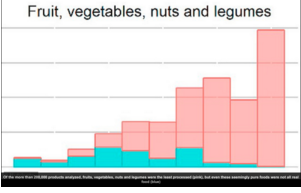
Manufactured Foods Maim and Kill
If whatever you’re eating or drinking right now came prepackaged, odds are it’s more lab product than actual food, a new study finds.
The Western diet is a primary driver of the American obesity epidemic, and that diet is notoriously high in sugar, fat and processed foods.
In fact, the majority of snacks, breads, cookies, dressings and drinks that come in a package are not just processed but ultra-processed, according to new Northwestern University research.
Over 70 percent of the 200,000 pre-packaged products the scientists analysed were mostly made in the lab or extracted from whole foods or developed in a lab – and if the current trend continues, that number will keep creeping toward 100 percent.

The US has been processing food since the 1940s – beginning with M&Ms, first manufactured in 1941.
Processing is a catch-all term for a number of techniques to modify meats, vegetables and fruits, including everything from chopping to extracting components or oils to freeze drying, removing toxic aspects and adding preservative chemicals.
The upside is these foods last longer and are faster and easier to prepare for consumers.
But these process usually also mean that by the time you’re eating or drinking a packaged food, it has less nutritional value than its source material did, and may have additives like sugars and preservatives that make the product less healthy.
The US requires labeling that discloses nutritional values and makeup for packaged foods, but doesn’t have a formalized rating system for them.
So to get a standardized measure and comparison, the Northwestern University used the Health Star Rating system endorsed for ranking the quality and healthiness of packaged foods in Australia and New Zealand.
On average, the packaged food scored just a 2.7 out of five possible Health Star points.
And 71 percent of the products fell into the ‘ultra-processed’ category, meaning that they consisted entirely or almost entirely of extracts and substances derived from food and concocted in the lab using gussied up fats and starches.
They contain next to no actual food, and are often mostly empty calories with little nutritional value.
Among the top 25 manufacturers of packaged food sold in the US, according to the international rankings from Euromonitor (which are pay-walled and not disclosed in the study), only one left non-negligible amounts of real food in more than half its products.
Over 90 percent of the products made by 14 out of those 25 companies were classified as ultra-processed.
‘To say that our food supply is highly processed won’t shock anyone, but it’s important that we hold food and beverage manufacturers accountable by continually documenting how they’re doing in terms of providing healthy foods for consumers,’ said lead study author Abigail Baldridge, a biostatistician in the Northwestern University Feinberg School of Medicine.
The worst of the worst food- and drink-like products were not sodas, or even power bars, but bread products.
Breads were high in unhealthy saturated fat, sugar, sodium and calories overall.
Perhaps unsurprisingly packaged fruits, nuts, vegetable and legumes and edible oils were the least processed, according to the new study, published in the Journal Nutrients.

But an alarming proportion of every category of the convenient, cheap, packaged foods we so easily toss into our grocery baskets were processed to within an inch of being food at all.
In May, a first-of-its kind National Institutes of Health (NIH) study found that highly processed foods are not only linked to but cause over-eating and weight gain.
Alongside this and a growing body of research on the dangers of the Western diet, the new study’s findings are ’cause for concerns, with US obesity levels and rates of chronic disease still heavily burdening the US health system,’ the authors wrote.
‘Research has shown that a significant positive association exists between national household availability of ultra-processed foods and national prevalence of obesity among adults.’
www.dailymail.co.uk
